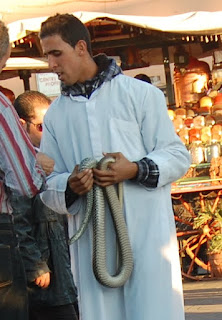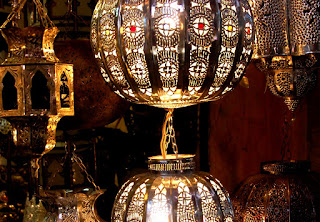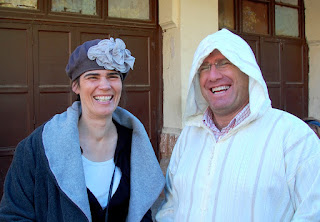The following summary to our wonderful Moroccan trip was written by one of our co-travelers; Rochele Abraham of London, England. We decided to include her summary, as she took detailed notes of all the historic Jewish sites that we visited. Rochele graciously agreed to allow us to include her diary of the trip in our blog.
Sunday November 6th, 3.30am
We started our trip bleary eyed but raring to go, alighting the bus to head to Gatwick
airport.
Shacharit elicited some raised eyebrows from gate 58 staff, but proceeded without any further hitches. The flight was smooth and we arrived to a sunny welcome in Morocco! After an extra long passport control, we met our guide Rafi and helper -‐ Felahi?! Felafel?! Mohammad?! who greeted us with a bottle of water, the first of many!
The bus travelled through the mellah (or is it medina?!) of Marrakech before stopping at the Bet El synagogue. The synagogue is the first one built outside the mellah. The heichal is 250 years old. Chief Rabbi Kadosh joined us for Mincha and spoke about the role played by himself and his late father in the city of Marrakech.
They are careful to keep the Torah scrolls under lock and key even though they are not usable because the locals have taken many scrolls, cut them up and sold them in the market. In light of this, Rabbi Kadosh's father buried many of the scrolls collected from the now defunct 42 local synagogues. We also met the emeritus shochet and mohel Rabbi Gabbay.
There are 140 Jews left from the 28,000 that there used to be. The large succah there was decorated with hanging etrogim that gave off a most beautiful fragrance.
At lunch in the courtyard we introduced ourselves and were amazed how we hail from all four corners of the world!
We continued our drive to Casablanca to visit the only Jewish museum in Islamic world. Kol hakavod to our guide Rafi for single handedly pioneering such a monumental task.
A bus tour of the city ended at the Bet El synagogue where Odette was danced in under a talit as a commemoration of her wedding that took place at this very spot! We prayed Arbit in this synagogue that was built in 1949 by Algerian Jews. The Jews make up less
than a half percent of the 81⁄2million population. However, there was zero percent intermarriage.
We moved on, and posed for a group photo outside the second biggest mosque in the world, before heading to the club for a typically Moroccan buffet supper. By the time we arrived at the Kenzi Tower Hotel, we were ready to fall in to bed!
Monday November 7th, 6.45am
Another early start -‐ for those who were able -‐ with Shacharit at the Nvei Shalom synagogue in the complex of the functioning Nvei Shalom school. Breakfast was beautifully laid out by Rabbi Sebbag's wife. Rabbi Sebbag, the Rabbi of the community encouraged us to be proud of our Judaism and he can talk. He had a miraculous recovery from being hit with an axe by a drunken Moroccan.
At the cemetery in Casablanca we all shared a very moving experience with Mr Fhima as he told us the story surrounding his father's death and then recited Kaddish with a minyan at his father's grave for the first time!
We also visited the grandparents of Rejane. Buried there too is Rabbi Chaim Pinto.
We continued on to the street of the 7 synagogues, side stepping the various parts of the lamb that were being slaughtered at every street corner, due to the Eid festival. Most notably were the Ben Harroch synagogue and the Aim Habanim synagogue where Mr Fhima had celebrated his Bar Mitzva. The names of the synagogues have been painted over since the bombing in 2003.
Next, we travelled to Rabat to visit the Mausoleum of King Mohammad V. Tzvi explained that whilst the king refused to give over a list of names of Jews during WWII, it is not to be assumed that the king always protected his Jewish residents.
On to the mellah of Rabat. Mellah means salt. The Jewish quarter is called mellah as the Jews were the salt traders. It is interesting to note that the Jewish Quarter is always near the king's palace. The king trusted the Jews so he gave them the salt trade, and thus benefitted by having them close by. Another reason is that, officially, the king would be able to protect the Jews if they were near him. The Jews did have to pay an extra tax for this privilege though.
Rabbi Hadad opened the Shalom Ezawi synagogue for us where we davened Mincha. Who knows when the last time was that this synagogue had a minyan?! There used to be
26,000 Jews living in this area, and now there are only two families that live here in the old Jewish quarter. The etrog and pomegranate tree growing in the courtyard of the synagogue is typical of the climate.
We enjoyed lunch (banana anyone?) en route to Meknes. Those not too tired, got off the bus to take a photo of the famous Bab El-Khemis gate. At the Aim Habanim synagogue and Talmud Torah school in Meknes, Jack, a local Jew, explained that this area is very poor and the synagogue served as a soup kitchen for the poor people.
We danced with Jack who was delighted to sing sefaradi songs with us. In the old cemetery, we visited the grave of Rabbi Refoel Hamalach, a great scholar and miracle worker. Many of the graves do not have names on as when a local was commissioned to clean up the cemetery, he painted over the tombstones. Also, many of those buried here are children who died from illness that was rampant in the Jewish quarter. These children were buried quickly so that the epidemic should not spread further and thus there was not the time to give each one an individual tombstone. This cemetery is 700 years old and is in a terrible state.
Mr Woolf pointed out how relevant the passuk, "shualim hilchu bo" - "Foxes will walk on it" is. This passuk is written in reference to the Temple where wolves walked freely amongst the rubble of the Temple. Here, sheep were jumping over gravestones!
The Bab Mansour gate was our last stop in Meknes and we took a few pictures before journeying on to Fez.
Once in Fez we proceeded to the Reuben Bensadoun synagogue where we prayed Arbit. It was built in 1929 but does not have a regular minyan today. Tzvi illustrated for us the pride and esteem in which Moroccan Jewry held their synagagues. The houses that the Jews lived in were far from palatial, yet the synagogues were made of the finest materials and decorated ornately. They realised that reverence to their places of worship would be their link to the continuity of Judaism. The Maimonides club was closed so we could not visit it (nisht geferlach!).
After checking in at the Ramada hotel, we sat down to supper and celebrated Florence Asher's birthday with what (we hope) was 'Happy Birthday' in Arabic. For those who were energetic enough, there was the opportunity to stroll along the boulevard (garden?!) and take in the atmosphere of modern Fez.
Tuesday November 8th, 6.45am
Tuesday dawned bright and early with davening at the Reuben Bensadoun synagogue. There are only 140 Jews left in Fez compared to the 30,000 Jews that were there originally. None live now in the Jewish quarter. After breakfast we were whisked onto the coach and taken to the mellah, the old Jewish quarter. We saw marks in the doorposts where the Jews had removed their mezuzot before they left the country.
The 17th century Ibn Danan synagogue has been restored by the family, so we sat
inside while Rabbi Garson regaled us with the story of Rabbi Shlomo Ibn Danan and how he came back from studying in Israel to lead the community of Fez. The king of Morocco would come every Yom Kippur to the synagogue for Ne'ilah and and stand there with his eyes closed right through the whole prayer.
On the floor a tile can be removed to reveal a mikveh in the basement. A metal pipe went from the ceiling to half way down inside the synagogue, and rainwater was collected for the mikveh. Rainwater was collected also for making matza, and next door the synagogue was a matza oven.
Our next stop was the old cemetery that dates back 700 years, but is still in use today. It has 7 layers of buried remains. Note how the tombs face different directions as the entrance to the cemetery changed over time. After visiting the gravesite of Rabbi Shlomo Ibn Danan, Tzvi taught us to celebrate the life of those departed, and to be inspired to make our mark too in this world.
Rabbi Garson then spoke very movingly about the righteous Sulieka who gave up her life 'al kiddush Hashem' - to sanctify G-d's name as she would not betray G-‐d by converting to Islam. She suffered a terrible death, but was still so particular to retain her modesty. We must live al Kiddush HaShem Rabbi Garson implored - possibly a much harder task. In a very emotionally charged atmosphere we sang at Sulieka's grave and lit candles whilst praying individual requests.
We also had the opportunity to pray at Rabbi Yehuda Ibn Attar's grave. He was kidnapped and offered back to the Jews at a very high ransom. The people were not able to amass such an exorbitant amount in the 24 hours they were given, so Rabbi Yehuda was thrown into the lions den. But he was totally unharmed by the lions, and thus gained the respect of the king.
Moving on, we stopped at King Mohammed IV's palace, admiring the hand crafted bronze gates. The seven doors symbolise the seven days of creation and the six gates to heaven with the seventh leading to paradise.
The Medina was our next destination. Tripping over the unevenly paved alleyways, we really got a feel of Moroccan life. We saw the home of the Rambam - supposedly - commemorated merely with a plaque.
Travelling through the labyrinth that is the medina, we visited a metal artisan, caftan crafters, leather finery and silk and wool weavers. At each stop we were educated as to how their craft was plied, and enjoyed a wonderful experience bargaining and haggling for their
wares. Tzvi illuminated for us what a privilege it is for us to see a tannery - this bringing alive the many mishnaot that deal with tanners.
We also made a stop at the University of Fez - oldest in the world, which was built by a woman named Fatima al-‐Fihri in the 9th century.
A most memorable coach journey led us up, around and through the Atlas mountains to reach our hotel for the night. The villages in the mountains where the Berbers live used to be home to 18 Jewish villages. The Jews reached here after they left Israel, from the time of the destruction of the second Temple. We witnessed a most beautiful sunset on the way, and passed the time hearing renditions from Zak and breaking out into peals of laughter from the entertaining jokes. For those who held out, a hot supper was served in the quaint Le Tazarkount Hotel.
Wednesday November 9th, 7.30am.
Another early start, to drive to Marrakech. We sniffed and smelled the spices as we experienced the mellah. Only 4 Jews live there now. We saw the Fundunk - the free guesthouse where Jews from the mountains could stay when they came to trade. Although there are a few Jewish owned shops in the mellah today, they were closed due to the Eid.
In the El Azama synagogue - which is still in use today - Rabbi Garson summed up the trip by asking us to take the lesson with us of being proud of our Judaism.
Then came decision time. We split into two groups, one going off to the Medina to relax and shop. The other group went back on the coach - destination Ourika! Travelling through the exquisite Atlas mountains, we headed towards the grave of Rabbi Shlomo Ben Lhans. Ben Lhans means son of the snake. It is said that after contesting the king's decision to raise the Jews tax, Rabbi Shlomo was thrown down a well.
After 3 days he was found eating apples brought to him by a snake. He was taken out of the well and gained the king's trust. There is one last Jew who lives by the grave and keeps watch over it. It is told that Rabbi Shlomo appeared to him in a dream telling him not to leave the area until he tells him to. Many (but not all!) of us sat next to Hananiyah Alfassi and
were blessed by him.
The men then broke out into song and danced around the grave. We then gave Hananiyah the opportunity to hear a Mincha with a minyan, after which we boarded the bus - whilst being accosted by jewelry hagglers - to rejoin the other group in Jemaa el-Fnaa Square.
The square is famous for magicians, acrobats, snake charmers and the like.
Supper was kindly cooked for us by Mrs Ohayon and awaited us in the Bet El synagogue - where we had started out. We had come full circle!
It was time to show our thanks and appreciation to those who made this trip possible; Rafi our guide par excellence (keinaina hoori!), Tzvi Sperber and Rabbi Garson - who both educated, uplifted and inspired us on the 4 memorable days in Morocco.
Thank you
































































